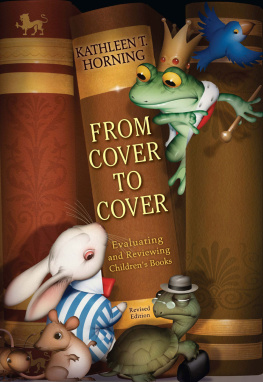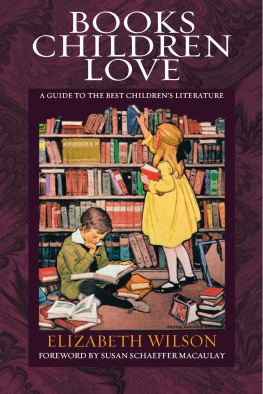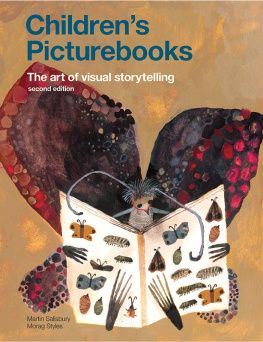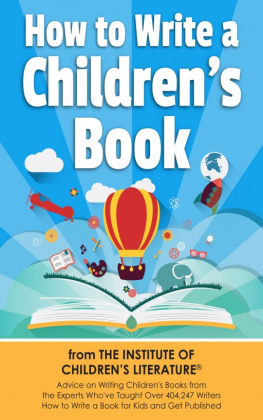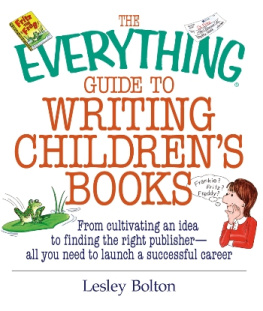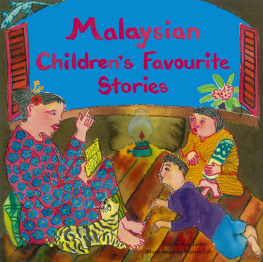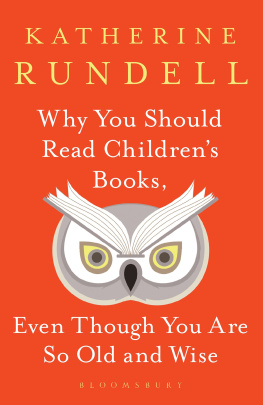For Emily
With approximately five thousand new books for children being published every year, it may seem an overwhelming task to wade through them. But with this embarrassment of riches, it is important for adults who work with children and books to sharpen their critical skills so they can select the best books available. But how do we determine which books are the best ones? What makes a good childrens book? Are there simple standards we can apply across the board? Or are there different sets of standards for different types of books? Or for different needs or audiences? This book is meant to serve as a beginning place for those who want to evaluate or review books published specifically for children. It will provide concrete examples of aspects to consider when looking at childrens books with a critical eye.
For our purposes, we will use the term evaluation to refer to a critical assessment of a bookin other words, the thought process one goes through in order to formulate an opinion of the book. Sometimes book evaluation can be done very quickly, drawing on a wealth of professional or personal experience; other times it requires a great deal of deliberation, careful thinking, perhaps even consultation with outside sources of information. This book will offer guidelines for evaluating the various genres of childrens books: nonfiction, folklore, poetry, picture books, beginning readers and easy chapter books, and fiction. It will also offer advice on how to write a review.
A review is a formal written expression of the critical assessment, generally printed soon after the book under consideration has been published. Good reviews help readers create a mental picture of the book by briefly describing it and presenting an assessment of its quality.
There are no quick, easy answers to this question because there are so many different kinds of childrens books that can be outstanding for different reasons. Furthermore, as times change and our perception of children evolves, so too do our standards for excellence in childrens books. Each chapter in this book will open with a brief history that will help provide a context for the type of books under discussion, followed by evaluative criteria, using examples from outstanding books. Newcomers to the field may wish to seek out these exemplary books to expand their general knowledge of childrens literature by reading some of the best books we offer children.
Its been more than ten years since the first edition of From Cover to Cover was published, and in that time there have been changes in the childrens book world. The chapters included here have been updated to reflect that, and the chapter on fiction now includes a section on subgenres. In each chapter new books have been included as examples of some of the best that childrens literature has to offer.
A Critical Approach to Childrens Books
Reading a book for the purposes of evaluation and review requires more attention to detail than reading a book for pleasure or for information. When you read to evaluate, your assessment of the book will ultimately affect other potential readers. It may make a difference as to whether or not a book is purchased for a library or a school or as a birthday gift for a child youll never meet. In fact, it may make a difference as to whether or not the book is read by a child at all. It is your professional responsibility to try to take your evaluation beyond a personal response.
This is not to say that your personal response doesnt matter. It would be impossible for you to put it completely asideyou are a reviewer, after all, not a robot. What the responsible reviewer strives for is an informed and reasoned opinion, clearly articulated so that others can learn about books they havent read.
In essence, a childrens book reviewer reads and writes with two audiences in mind: (1) adults who read reviews to help them select books for children and (2) the children themselves. If a review is printed in a publication that has a national distribution, it may also be read by the author and publisher of the book in question; however, neither is the intended audience for your review. In other words, it is not your goal to write a review to stroke an authors ego or to pick a bone with a publisher.
Still, it is important to remember that most books for children are created with the best intentions in mind. No one sets out to produce a crummy book that kids will hate. If this is your initial assessment of a book youre reviewing, it would be unfair and unwise to let it stand as your final one without a great deal of further consideration. Youll need to take a closer look at the book. What was the authors intent in writing the book? What qualities did the editor see that led him or her to believe that the book merited publication? Why did the illustrator choose this particular style? The answers to all these questions have their origins in the history of the books creation. While it isnt necessary for you to know the details of a books publishing history in order to review it, an understanding of the general context in which childrens books are created will help you read more critically.
Many publishing houses have divisions or departments that are devoted to publishing books for young people. These were, for the most part, established in the 1920s and developed through the pioneering efforts of women such as Louise Seaman Bechtel, May Massee, Helen Dean Fish, Marian Fiery, and Virginia Kirkus, who were the first childrens book editors. Unlike adult book divisions, which are driven by the consumer market (bookstore sales), childrens book divisions developed largely in response to an institutional market. Sales to libraries and schools accounted for a high percentage of the total number of childrens books sold. As library budgets began to shrink in the 1970s and 1980s, childrens book publishers began to turn their attention toward consumer sales as well, although the institutional market continues to be an important influence in the childrens book industry.
There are books that are created specifically for one market or the other. Those that are produced for the institutional school market alone are called textbooks. They are generally sold to entire school districts rather than to individuals. They are also created in a separate division of the publishing industry that specializes in producing books to fit the exact needs of teachers working with specific school curricula and guidelines at various grade levels. Books that are produced with only the consumer market in mind are called mass-market books . These are generally produced as paperbacks or as picture books with inexpensive cardboard covers (such as Little Golden Books) and they may be sold in supermarkets, airports, drugstores, and convenience stores as well as in bookstores. While there are publishers that specialize in producing mass-market books, most childrens book departments produce mass-market books to some degree.
Books created for both the consumer market and the institutional market are called trade books . These are sold to schools and libraries, and they are also sold directly to consumers through bookstores. Both quality and child appeal are taken into account when weighing the sales potential. From the publishers point of view, the best kind of childrens trade book is one that will succeed in both the consumer and the institutional market and will continue to sell well for decades. This is the type of success guaranteed by a book that wins the Newbery or Caldecott Medal.
Most childrens books start out as an idea in the mind of an author. That may seem obvious to you, but I mention it here because many people seem to have the notion that ideas start with publishers, who then assign them to authors. People often ask childrens editors: Why dont you publish more books about X? in a tone that suggests they hold editors personally responsible for the lack of X books. But editors dont tell authors what to write. They must wait for X to develop in the mind of the author, and then they have to determine if its good enough to publish. The editors role is to find and nurture the talents of authors and artists who will create good childrens books. If they cast their nets widely enough, their catch may include an author who will come up with the idea of writing about X on his or her own.

